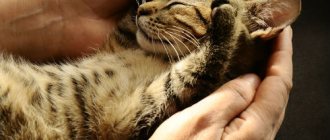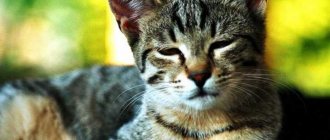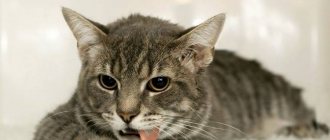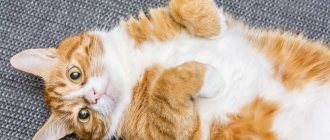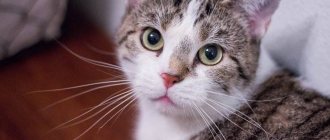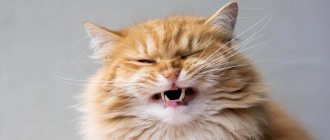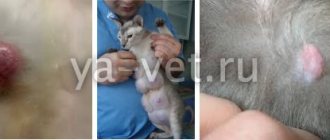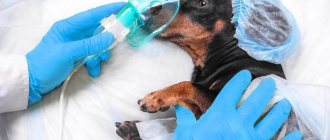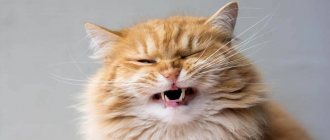If your pet has an incomprehensible cry, meowing or wheezing, you should contact your veterinarian. Sometimes a cat wheezes and sniffles when breathing due to the accumulation of fluid in the bronchi, but other factors can also influence the occurrence of an unpleasant symptom. With many deviations, owners observe that the pet is not only hoarse, but also salivates profusely, breathes poorly, the volume of fluid in the nose increases and behaves restlessly. It is difficult to treat the disorder on your own, and sometimes even dangerous for the health and life of your pet, so as soon as the cat’s voice has disappeared, you should immediately contact a veterinary clinic.
Varieties
If the owners find that the cat wheezes when he breathes, wheezing and other pathological noises are recorded, then it is worth taking the pet to the veterinarian. Such a violation is divided into several types, presented in the table:
| Type | Peculiarities |
| Fine bubbles | The pathological sound is a consequence of the collapse of small air balls that are formed during sputum |
| Such wheezing is heard when the pet is sleeping or awake, and is characteristic of bronchitis, pneumonia and pulmonary infarction. | |
| Medium bubble | Reminds me of the sound of air blown through a tube |
| Observed with inflammation of the bronchi, which is associated with abundant accumulation of mucus | |
| Large-vesicular | Can be listened to without special devices |
| The cat exhibits noisy breathing with severe wheezing, and the pet can often burp liquid accumulated in the lungs | |
| Caused by pulmonary edema |
Veterinarians note that the cat may experience wheezing, whistling, dry or wet. At the same time, different types of noise are associated with different reasons and require special treatment.
First aid
If the animal suddenly stops breathing, it is necessary to perform chest compressions and artificial respiration. Place the pet so that the neck is an even continuation of the spine.
- Clean the mouth from excess mucus, saliva and foreign objects and close it.
- The palms form a tube to inhale air into the cat’s nose; the frequency of inhalations should depend on the size of the animal. Up to 20 breaths should be taken within one minute. If the kitten is small, then the frequency must be reduced, otherwise there is a high risk of damage to the pet’s lungs due to the large volume of air.
- If rhythm is completely lost, you need to do an indirect massage. Place the palm of one hand over your chest so that your thumb moves away from the rest. Rhythmically clench and unclench your fingers 5 times - exhale into your pet’s nose. In this case, you should check your pulse every 2 minutes.
Why is there a problem?
Pulmonary causes and additional symptoms
Cough is one of the main symptoms of rhinotracheitis in an animal.
If the kitten does not meow and its respiratory rhythm has changed, then in most cases the problem is associated with pathologies of the respiratory system. Many pulmonary diseases are characterized by copious secretion of saliva and mucus, which the pet often swallows. If a cat is breathing heavily and wheezing constantly, then this indicates a number of pathologies presented in the table.
| Disease | Short description | Additional symptoms |
| Rhinotracheitis and calcivirosis | The mucous membranes of the respiratory tract and intestines become inflamed | Heat |
| Diarrhea | ||
| Cough and severe wheezing | ||
| Ulcers on the mucous membranes | ||
| Purulent and mucous discharge from the eyes and nose | ||
| Pneumonia | Inflammatory reaction in the lungs associated with viruses and bacteria | Barking type cough |
| Temperature increase | ||
| Deterioration of general condition | ||
| Bronchial asthma | Chronic inflammation of the airways with narrowing of the pulmonary lumen | Frequently pressing the cat to the floor |
| The animal is breathing hoarsely and coughing | ||
| In advanced cases, the pet suffocates | ||
| Helminthiasis | Associated with the entry of small parasites into the respiratory tract | Vomiting and nausea |
| Breathing with wheezing | ||
| Broken stool | ||
| The pet eats almost nothing | ||
| Cancerous tumors | Accompanied by the proliferation of malignant cells in the respiratory organs | The cat grunts and sniffles when it breathes |
| Changed voice, and sometimes meowing disappears completely | ||
| Shortness of breath and cough with bloody impurities | ||
| Laryngeal edema or laryngospasm | Occurs against the background of poisoning with household chemicals, an allergic or autoimmune reaction | Acute lack of oxygen |
| Restless state | ||
| The cat meows hoarsely and moans often |
Other reasons can also affect heavy breathing in a cat and severe wheezing:
The animal may experience difficulty breathing due to the triplication of the skull.
- foreign body entering the throat;
- brachycephalic syndrome;
- pulmonary edema;
- congenital anomalies;
- tracheal collapse.
Non-respiratory sources
When a cat has hoarse breathing accompanied by a loud sound, this does not always signal a pathology in the respiratory system. Often a cat grunts and breathes through his mouth due to the following disorders:
- Protrusion of the diaphragmatic hernia. The symptoms are reminiscent of bronchial asthma, with the pet constantly being in one position and breathing heavily.
- Heart diseases. In case of heart failure, the animal rarely develops a cough, and the cat often wheezes and breathes through his mouth. Arrhythmia, myocardosis and myocarditis can affect impaired breathing.
- Severe renal failure. The pathology often provokes pulmonary edema, as a result of which the pet refuses to eat, is constantly in a semi-sitting position and coughs.
Symptoms
A life-threatening sign is intermittent inhalation and exhalation with coughing.
- Cat wheezing - manifested by noises, whistling due to narrowing of the airways. They arise both due to the accumulation of excess fluid - hydrothorax, and a large amount of air - pneumothorax. With obstruction, gurgling sounds may be observed in whistling and wheezing.
- Coughing is a protective reaction due to which the respiratory canals are cleared of foreign objects, pus, mucus, fluid and other irritants. May occur due to a cold or have other dangerous causes.
- When breathing, the cat not only wheezes, but also has hoarseness - a very dangerous symptom. The voice may deepen due to the growth of a malignant neoplasm, and a cough with blood clots in the mucus may additionally appear, and the cat wheezes when breathing.
Diagnostics
At the appointment, the doctor may examine the animal’s throat.
If your cat becomes hoarse, breathes with its tongue hanging out, and sneezes frequently, then you should immediately contact a veterinary clinic. Such symptoms indicate serious illnesses in the respiratory and other systems of the cat’s body. During diagnosis, a specialist uses special instruments to examine the animal’s throat to detect a foreign object, which most often leads to wheezing. The veterinarian asks the animal owner what other symptoms have been present and for how long. If the cat begins to breathe heavily in its stomach, wheeze and cough, then to make an accurate diagnosis and find out the cause of the problem, the following diagnostic procedures are performed:
- laboratory testing of blood and urine;
- analysis of feces for the presence of helminths;
- biopsy of damaged tissue;
- ultrasound diagnostics;
- radiography.
Causes of wheezing with heavy breathing
This is noisy bubbling breathing. It can occasionally be caused by a cold, and also accompanies most diseases of the respiratory system. A cat often wheezes for the following reasons :
- foaming of accumulated liquid (blood, trans- or exudate);
- the gaps in the respiratory tract narrow.
When the animal loses its voice, it wheezes for a long time. This indicates a violation of the vocal cords, their incomplete closure. The animal will wheeze until they are fully recovered. This phenomenon occurs when mucous fluid accumulates in crevices or with laryngitis.
Changes in a cat's breathing may be a consequence of obesity. In this case, even after little physical activity the animal breathes heavily. Sudden wheezing may indicate that the cat has swallowed a foreign body that is stuck in the throat. You can't try to pull it out on your own. Why can't pet owners do this? Without qualified help, the object can be pushed even further and the animal will die.
What to do and how to treat?
If your cat wheezes, has stopped meowing, and other alarming symptoms are observed, then you should immediately seek veterinary help. If nothing is done for certain diseases of the respiratory system, the pathology rapidly progresses and can lead to severe shortness of breath, lack of oxygen and death of the pet. Therapeutic measures are selected individually for each pet, depending on what is causing the cat’s wheezing. If owners observe that the pet is constantly trying to clear its throat and wheezing, then there is a high probability of a respiratory disease. In this case, you must adhere to the following therapeutic actions:
If the animal refuses to drink, you need to use a syringe without a needle to inject water.
- Provide the cat with constant access to drinking water. If the animal refuses, then try to inject the liquid with a syringe.
- Constant air humidification and ventilation in the place where the sick pet lives.
- Taking medications that provide symptomatic treatment.
Veterinarians warn that if a cat has a hoarse voice due to respiratory failure or asthma, then forceful watering is strictly prohibited. In this case, excess fluid is removed from the lungs, and in severe cases, surgery is performed.
Medications should be given to a sick animal for wheezing only on the recommendation of a veterinarian, since many of them have contraindications and can cause complications. If wheezing is associated with diseases of an infectious nature, then therapy must be supplemented with antibiotics. If the symptoms are accompanied by foamy nasal discharge with bloody impurities, then emergency hospitalization of the animal is required, since the risk of death is high.
Pleurisy
Pleurisy is the accumulation of fluid in the space between a cat's lungs and the chest wall. Occurs mainly due to heart failure, infectious peritonitis, neoplasia. The latter involves the accumulation of pus in the pleural cavity. In these cases, the cat has serious breathing problems and a wheezing sound appears due to the inability of the lungs to expand properly. In addition to wheezing and coughing, the cat develops restlessness and bluish mucous membranes of the tongue. Treatment of pleurisy should begin immediately, immediately after detecting any of the clinical signs and confirming the diagnosis.
Prevention measures
To prevent your cat from wheezing, you need to regularly monitor his health and regularly visit the veterinarian. Timely deworming and vaccination help reduce the likelihood of difficulty breathing. In most cases, wheezing is recorded due to disorders of the respiratory tract. To prevent such diseases, you should not allow hypothermia and give your pet cold food and water. It is important to eliminate all possible allergens and monitor the animal so that it does not ingest any foreign objects. If you have difficulty breathing or other alarming symptoms, you should not self-medicate, but should immediately contact a veterinarian so that your pet does not die.
Treatment
To keep your cat healthy, you need to periodically take him to the doctor. Only a specialist can determine why a cat wheezes when he breathes. It is also important to carry out all types of vaccinations, monitor hygiene, and add vitamins to the diet.
The veterinarian identifies the causes of wheezing in a cat when breathing and knows how to treat inflammatory, viral, and bacterial infections.
- Helminths are removed by a course of treatment with special means. Antiparasitic drugs are toxic and cause serious damage to the animal's liver, kidneys and other organs, including death. For this reason, dosage and supervision by a veterinarian are important, especially if the kitten is wheezing or coughing.
- A cough can be triggered by a common allergic reaction, either to a food product or to a chemical or plant. Bronchial asthma occurs and is eliminated with the help of drug therapy, antioxidants, vitamins and a special inhaler.
- The cat wheezes - problems in the cardiovascular system occur mainly in overweight and old cats. An examination by a veterinarian, examination using electrocardiography and x-rays are required. Appropriate treatment and dietary type of food are prescribed.
It is strictly not recommended to self-medicate; an animal’s body is as fragile as a human’s. This is the same family member whose life should be in the hands of an experienced specialist.
Diagnosis of the respiratory system: how a veterinarian determines the presence of diseases
Most often, diagnostics of the respiratory system is carried out using a combined method; a specialist can use several methods at once:
- Auscultation (listening to the chest organs). All you need is a phonendoscope. The method allows you to detect wheezing in the lungs and bronchi.
- Percussion (tapping the chest). In this case, an experienced specialist can quite accurately determine the boundaries of organs, the presence/absence of fluid, etc. Note that the study can give good results only in cases where the qualifications of the specialist performing percussion are sufficiently high.
- X-ray. The technique is simple and cheap; equipment for its implementation is available in almost every large veterinary clinic. However, sufficiently high-quality images can be obtained only if special contrast compounds are introduced into the animal’s blood before the study. The pictures are clearer and it is easier to notice signs of pathologies.
- Ultrasound examination of the chest organs. The technique is also common and, moreover, can provide better data, since the method is excellent for soft tissue studies. But ultrasound is a method, the result of which depends even more on the qualifications of the performer. Therefore, the breeder’s task is to select a really good specialist.
Therapeutic techniques
In the clinic, after clearing the airways, the veterinarian can start breathing using artificial respiration, inserting an endotracheal tube and connecting to a ventilator. An indirect cardiac massage, a defibrillator and injections of drugs (adrenaline, atropine, atipemazole, etc.) help a specialist to start a stopped heart. Depending on the results of resuscitation efforts, studies are prescribed to establish a diagnosis, treatment and further care.
Regular preventive examinations and tests will help identify diseases in the early stages, without leading them to a chronic form. If you have congenital or chronic diseases, you should follow your veterinarian's recommendations for caring for your cat. An attentive and caring owner will always notice suspicious symptoms and seek advice from a specialist, because the life and health of the cat is in his hands.
What breathing is normal?
Normal breathing in a cat is a calm and uniform rise and fall of the chest, without jerks or convulsive movements. If a cat breathes from its stomach and sides, this means that the respiratory tract is impaired, and it is painful for the pet to breathe naturally. Worry should be caused by the appearance of wheezing or loss of voice.
If a cat wheezes, it means he is sick with something.
Note! If a cat wheezes quietly while breathing during sleep, and there are no convulsive sighs or wheezing, this is normal.
Treatment in clinical and home settings: which therapy is preferable
For diseases of the respiratory system, cat treatment can be used both clinically and at home. Note that only the simplest operations can be performed at home, and in case of serious illnesses such treatment is completely contraindicated.
The owner can do the following independently:
- Give antibiotics.
- Give bronchodilators and mucolytics.
In other cases, treatment can only be carried out in a clinical setting:
- For cancer, foreign bodies and tracheal collapse, surgery is indicated. The same goes for all serious chest injuries.
- For pneumonia and bronchitis, complex broad-spectrum antibiotics are prescribed. In order for the treatment to be effective, pre-seeding is done on nutrient media and the type of pathogen is accurately determined.
- Asthma attacks are treated with powerful antispasmodics and bronchodilators. The veterinarian’s task is to select the minimum effective dose, since the animal will have to “sit” on these drugs for the rest of its life.
